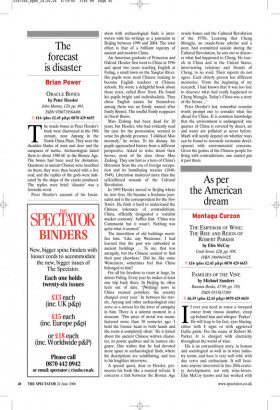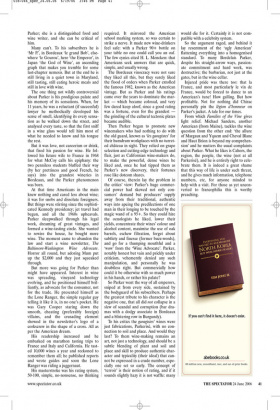As per the American dream
Montagu Curzon
THE EMPEROR OF WINE: THE RISE AND REIGN OF ROBERT PARKER by Elin McCoy Grub Street, £20, pp. 309, ISBN 190494342X ✆ £16 (plus £2.45 p&p) 0870 429 6655 FAMILIES OF THE VINE by Michael Sanders Bantam Books, £7.99, pp. 350, ISBN 0553817280 ✆ £6.39 (plus £2.45 p&p) 0870 429 6655 If ever you need to rouse a vineyard owner from vinous slumber, creep up behind him and whisper ‘Parker’. He will leap to his feet, eyes blazing, either with $ signs or with aggrieved Gallic pride. For the name of Robert M. Parker Jr is charged with electricity throughout the world of wine.
His is an extraordinary story, in human and sociological as well as in wine industry terms, and here is very well told, with due verve and enthusiasm. It will fascinate anyone interested in late 20th-century developments, not only wine-lovers. Elin McCoy knows and has worked with Parker; she is a distinguished food and wine writer, and she can be critical of him.
Many can’t. To his subscribers he is ‘Mr P.’, in Bordeaux ‘le grand Bob’, elsewhere ‘le Gourou’, here ‘the Emperor’, in Japan ‘the God of Wine’, an ascending graph that makes you tremble for some last-chapter nemesis. But at the end he is still living in a quiet town in Maryland, still tasting, still eating heroic meals and still in love with wine.
The one thing not wildly controversial about Parker is his prodigious palate and his memory of its sensations. When, for 11 years, he was a reluctant (if successful) lawyer he methodically developed his sense of smell, identifying its every sensation as he walked down the street, and analysed every taste, so that the first sniff in a wine glass would tell him most of what he needed to know and his tongue the rest.
But it was love, not careerism or drink, that fired his passion for wine. He followed his future wife to France in 1968 for what McCoy calls his epiphany: the two penniless students bluffed their way (by her prettiness and good French, he says) into the grandest wineries in Bordeaux, and the Parker phenomenon was born.
At that time Americans in the main knew nothing and cared less about wine; it was for snobs and dissolute foreigners. But things were stirring since the sophisticated Kennedy presidency; jet travel had begun, and all the 1960s upheavals. Parker sleepwalked through his legal work, dreaming of great vintages, and formed a wine-tasting circle. She wanted to rewire the house, he bought more wine. The moment came to abandon the law and start a wine newsletter, The Baltimore-Washington Wine Advocate. Horror all round, but adoring Mum put up the $2,000 and they just squeaked through.
But more was going for Parker than might have appeared. Interest in wine was spreading, vineyard technology evolving, and he positioned himself brilliantly, as advocate for the consumer, not for the trade. He presented himself as the Lone Ranger, the simple regular guy telling it like it is, in no one’s pocket. He was Gary Cooper staring down the smooth, cheating (preferably foreign) villains, and the crusading element showed in the newsletter’s logo of a corkscrew in the shape of a cross. All as per the American dream.
His readership increased and he embarked on marathon tasting trips to France and Italy and California. He tasted 10,000 wines a year and reckoned to remember them all; he published reports and wrote guides and soon the Lone Ranger was riding a juggernaut.
His masterstroke was his rating system, 50-100, simple, no-nonsense, no thinking required. It mirrored the American school marking system, so was certain to strike a nerve. It made new wine-drinkers feel safe: with a Parker 90+ bottle on your table no one could call you an oaf. The few cynics cited H. L. Mencken: that Americans seek answers that are quick, simple, and usually wrong.
The Bordeaux vinocracy were not sure they liked all this, but they surely liked the flood of orders when Parker extolled the famous 1982, known as the American vintage. But as Parker and his ratings came over the years to dominate the market — which became colossal, and very few dared keep aloof, since a good rating was a fortune, even for the grandest the grinding of the cultural tectonic plates became audible.
Then Parker began to promote new winemakers who had nothing to do with the old guard, known as ‘les garagistes’ for their humdrum workplaces with no turreted château in sight. They relied on grape selection and cutting-edge technology and flair, just as Californian wine-makers do, to make the powerful, dense wines he liked and, once he had tipped them as Parker’s new discovery, their fortunes rose like dotcom shares.
Of course, therein lay the problem in the critics’ view: Parker’s huge commercial power had skewed not only consumers’ demand but producers’ supply away from their traditional, authentic ways into apeing the predilections of one man in their longing to be touched by the magic wand of a 95+. So they could hire the oenologists he liked, lower their yields, concentrate their wines’ colour and alcohol content, maximise the use of oak barrels, eschew filtration, forget about subtlety and finesse (former buzz-words), and go for a thumping mouthful and a ‘wow’ from the ‘Wine Advocate’. Parker, notably honest but vain and prickly under criticism, vehemently denied any such manipulation, and personally he was doubtless right. But commercially how could it be otherwise with so much power in his hands, or rather his palate?
So Parker went the way of all emperors, sniped at from every side, sustained by the bodyguard of his subscribers. Perhaps the greatest tribute to his character is the negative one, that all did not collapse in a slew of scandal and corruption (bar dramas with a dodgy associate in Bordeaux and a blistering row in Burgundy).
To his critics the garagistes’ wines were just fabrications, Parkerisé, with no connection to soil and place. And would they last? To them wine-making remains an art, not just a technology, and should be a subtle blending of plant and soil and place and skill to produce authentic character and typicality (their ideal) that cannot be expressed in a crude number, especially one set so early. The concept of ‘terroir’ is their notion of rating, and if it sounds slightly hazy it is not waffle: many would die for it. Certainly it is not compatible with a celebrity system.
So the argument raged, and behind it lay resentment of the ‘ugly American’ flattening everything into a homogenised standard. To many Bordelais Parker, despite his straight-arrow ways, passionate commitment and hard work, was destructive; the barbarian, not just at the gates, but in the wine cellar.
Injured pride was there too: that la France, and most particularly le vin de France, would be forced to dance to an American’s tune! How galling. But how profitable. Not for nothing did Chirac personally pin the légion d’honneur on Parker’s jacket. A tale for our times.
From which Families of the Vine gives light relief. Michael Sanders, another American (from Maine), tackles the wine question from the other end: ‘the allure of Margaux and Yquem and Cheval Blanc and Haut Brion is beyond my comprehension’ and he mutters the usual complaints about Parker. What he likes is Cahors, the region, the people, the wine (not at all Parkerisé), and he is entirely right to celebrate them. It is indeed a great shame that this way of life is under such threat, and he gives much information, telephone numbers, etc, for anyone minded to help with a visit. For those as yet unconverted to francophilia this is worthy preaching.




















































 Previous page
Previous page